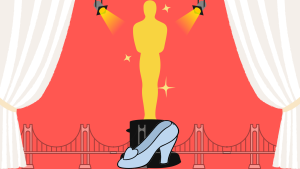
“American Dream: an American social ideal that stresses egalitarianism and especially material prosperity” — definition by the Merriam-Webster Dictionary
Jazz music and chorus line girls. Flappers and illegal booze. Whatever you choose to call it—The Jazz Age, Prohibition, The Roaring Twenties—the 1920s defined U.S. history with the glitz, glam, and economic prosperity that highlighted the grandness of a post-war society.
Perhaps nothing defines the qualms and quarrels of American society as F. Scott Fitzgerald’s “The Great Gatsby.” Published on April 10, 1925, “Gatsby” turns 100 this April at its peak of fame. From a literary favorite of high school English teachers to movie adaptations and most recently a Broadway musical starring Newsies’ Jeremy Jordan as the titular character, “Gatsby” remains in the periphery of the American public.
Set in 1923, at the height of the Roaring ‘20s, “Gatsby” is narrated by Nick Carraway, a Yale graduate and bondsman from the Midwest who moves to West Egg—a fictional place located on modern day Long Island—after World War I. In a novel interspersed with political and social commentary, Carraway tells a story about his mysterious neighbor, known only as Gatsby. Gatsby, as readers soon learn, was an Army man, in love with Carraway’s cousin Daisy Buchanan, who lives across the bay in East Egg. Daisy, while requiting Gatsby’s love, is married—albeit lovelessly—to Tom Buchanan, who is engaged in an affair with Myrtle Wilson, the wife of a gas station worker in Queens.
Fitzgerald writes each character to be the personification of a 1920s stereotype:
Nick Carraway—the war veteran, whose life has been unsettled by the end of the Great War, comes to New York looking for a fresh start, something new that the Midwest can’t bring.
The Buchanans—who live in East Egg, the home of those who possess “old money” or those who are born into riches.
Daisy—who represents the traditional American woman but who wants something more in her life.
Tom—representative of the anti-immigrant, traditional views held by many White Americans during the decade.
Jordan Baker—the feminist (women gained the right to vote at the beginning of the decade with the passage of the nineteenth amendment)—who isn’t afraid to lie or bend the rules to make the world hers, reminiscent of the flapper girls of the era.
The Wilsons—who don’t have the same economic luxury as the Buchanans.
George—whose only goal is to make life better for his wife so that one day they can leave Queens and start somewhere fresh.
Myrtle—who believes that her affair with Tom is her ticket out of poverty, even with the abuse she faces from him.
Then there is Jay Gatsby, the personification of the American Dream, or perhaps a critique of it. Gatsby, as Carraway said at the end of the novel, “believed in the green light, the orgastic future that year by year recedes before us.” Even at 100, the message—the yearning for the green light—remains relevant today.
Like many who settled in New York City in the early twentieth century, Gatsby was drawn in by the appeal for a better future. On the base of the Statue of Liberty, which could be seen by immigrants arriving at the docks of Ellis Island, there is a quote that reads, “give me your tired, your poor, your huddled masses yearning to breathe free, the wretched refuse of your teeming shore. Send these, the homeless, tempest-tossed to me, I lift my land beside the golden door!”
It’s a welcome to America, indicating that the door of freedom and hope is wide open. The rich, as we see in Gatsby, are simply a social construct. Gatsby capitalizes upon Prohibition and the sale of illegal alcohol to gain his wealth but builds his personal life off of a lie. The people of New York, of Long Island, flock to his parties as he flaunts his wealth, but in the end when he’s gone, no one appears for the funeral.
American high society tries its hardest to work against the American Dream, against the freedom and prosperity immigrants believe they’ll gain, because aren’t we “The Land of the Free?”
Now, 100 years later, the myth of the American Dream has faded from the world’s purview, as many countries have caught up to the United States in economic prosperity. The stereotype still exists though, as high society and bureaucrats rule the nation, the Gatsbys of the world, the ones who dream of going from rags to riches—to own a house and pay the mortgage, to have good healthcare, to pay for childcare and send your children to good schools—they still exist.
The 1920s saw a shift away from progressivism under Presidents Roosevelt and Wilson and toward conservative policies put in place by Harding that revolved around American isolationism and traditionalism, curbing immigration being the big thing. We’re seeing this parallel in today’s society where the Republican Party won the majority in all three branches of government in the 2024 election because the American public became dissatisfied with the current state of government and believed that the left was not doing enough to solve the problems plaguing the majority. Let history reflect that it was the left that pulled the U.S. out of the Great Depression, following twelve years of Republican presidents.
The boom of the 1920s was in part fueled by right-leaning policies like laissez-faire economics (which means little to no government involvement), but the concept of laissez-faire allows only big business to thrive, and when the stock market crashed in October of 1929, everyone suffered because of it. Laissez-faire, in comparison to the passing of modern day tariffs, are supposed to be American-first, yet they seem only to help the rich and hurt the poor.
It is the American government that is supposed to be the protector of the American Dream, yet it is the one that is concurrently taking it away.
Gatsby believed in a better future, the American Dream that is in front of everyone, just slightly out of reach.
“So we beat on, boats against the current, borne back ceaselessly into the past.” – F. Scott Fitzgerald
The opinions on this page do not necessarily reflect those of The Sandspur or Rollins College. Have any additional tips or opinions? Send us your response. We want to hear your voice.











Comments are closed.